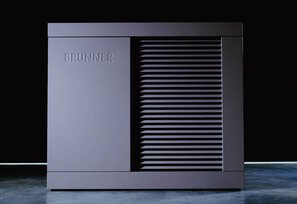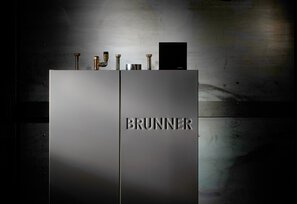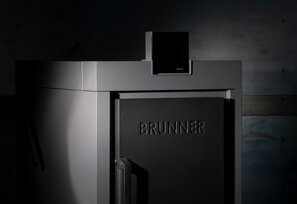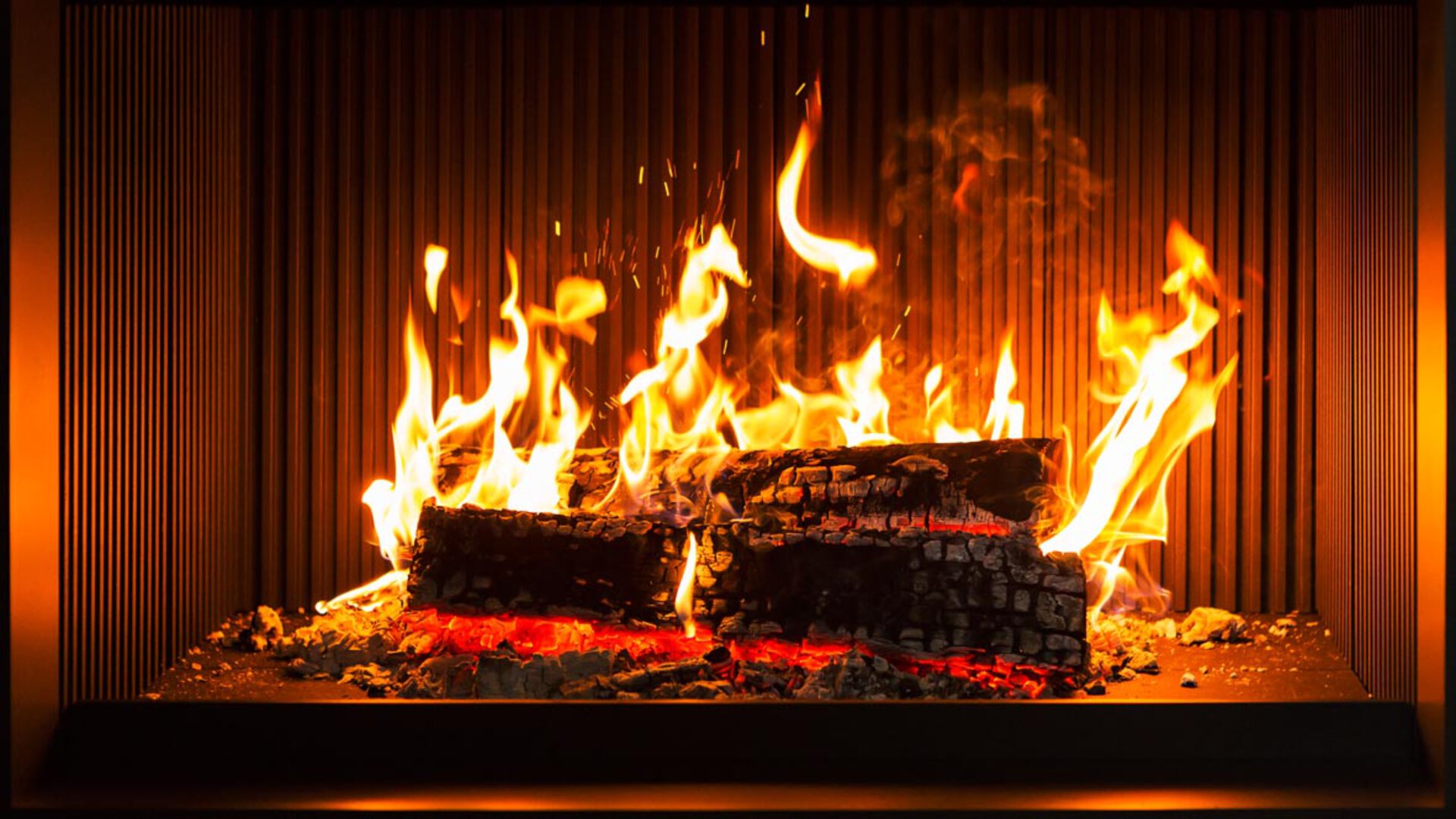Heat pump
Particularly popular in new build
Possible in unique combination with a wood stove
Heat pump heating systems are becoming increasingly popular and are now installed in many new German buildings. There are good reasons for this: A heat pump is very efficient, it uses renewable energy and produces no CO2 itself. However, it needs a lot of electricity when the outside temperature is low. Unless you combine it with individual furnaces or integrate it into a sophisticated heating system, this reduces the costs considerably.

Tip
Biomass is popular
Take your chance and get the current subsidy for existing buildings: Old heating systems in existing buildings are replaced with new, lower-emission devices that generate heat with renewable energy. To receive the subsidy, it is important to apply for it in advance directly on the BAFA page.
Compact monobloc with environment-friendly refrigerant
Awarded with the EHPA seal of approval
With a footprint of only 1 m², this compact monoblock heat pump operates fully modulating. The refrigerant used is propane gas R290 with GWP* 3. Due to this natural refrigerant, high capacities with a very good efficiency over the entire operating range are possible - high flow temperatures up to 69 °C lead to increased performance. Generously designed components also stand for a long service life and high efficiency. The heating output is adapted to the actual heat requirement. The EHPA seal of approval stands for the outstanding quality of a heat pump and has been tested accordingly by TÜV. Low-noise operation is guaranteed by appropriate components and perfect sound insulation. In addition, the BWP 4/14 green offers the added value of a cooling function.

Heat pump heating
Air-source heat pumps are in vogue
They use the regenerative solar energy stored in the air for heating purposes. In doing so, they are highly efficient without causing any emissions themselves. Their installation is easy and close to the building. The BRUNNER BWP 4/14 green heat pump is even quieter and its volume is more than 30 percent smaller than its predecessor. The colour scheme in light grey has been deliberately chosen so that the system blends very discreetly into the background. The high-quality metal housing "made in Germany" has excellent sound insulation. Its cooling function is a special advantage of the BRUNNER heat pump, which is controlled in a user-friendly way via a touch display. If a BRUNNER heating centre is integrated, it is located in the living room or in the boiler room.
Heat pumps usually use chemical and fluorescent refrigerants, which are harmful to the environment. That is why the new BRUNNER heat pump BWP 4/14 green uses a completely natural refrigerant: R290. In addition to its environmental friendliness, this has other advantages. Its physical properties are better than those of conventional refrigerants, which allows higher flow temperatures and a greater energy yield - and that saves costs. With R290, the GWP values (3), which describe the global warming potential of a refrigerant, are extremely low. The EHPA seal of approval certifies that the new BRUNNER heat pump is of outstanding quality and complies with the required standards. This is also important with regard to government subsidies or legal requirements. If heat pumps are operated with R290, they also do not have to be checked annually for leaks, as is usually the case.
We offer a functional guarantee with the BHZ and BWP hydraulic solutions. In conjunction with the BRUNNER heating system, the heat pump can be expanded and combined as desired. Whether with hot water preparation via a fresh water station, additional heating circuits or the use of surplus photovoltaic electricity. System integration in combination with BRUNNER boiler modules is simple. And all this with a single control and a uniform user interface: with just one glance at the glass touch display, you can see all the important parameters regarding the status of the heat pump as well as buffer tank temperatures. A simple and clear display ensures self-explanatory operation of the entire heating system.
System solutions
The BRUNNER concept
The real advantages of a heat pump come into play when all heat generators and consumers in a building function as a common heating solution and are integrated into a heating concept. "Heat pump heating PLUS" is what BRUNNER calls this. This concept is based on a larger, central system storage tank, which is designed as a stratified storage load. Here, the yields from the heat pump, the water-bearing wood-burning stove or other heat generators are collected, stored and passed on to the heating system as required. The system storage and hydraulic box are specially adapted to the requirements of the BRUNNER heat pump. The heat generators and heat consumers are only connected. Heat consumers can be up to six heating circuits, for example wall heating, radiators, underfloor heating. All hydraulic components in this system are already pre-assembled and matched to each other in terms of control technology, just like the eco-hierarchical operating mode of the regenerative heat carriers.

Let's go green
The new BRUNNER heat pump
With the BWP 4/14 "green", BRUNNER is launching a new heat pump on the market. The optimised device delivers more power and lower costs at the same time. It is also even smaller and quieter. BRUNNER uses propane instead of the usual chemical and fluorescent refrigerant, which would pollute the environment considerably, especially in the event of a leak. Its physical properties are also better than those of conventional refrigerants. They allow higher flow temperatures and a greater energy yield. Another advantage: the GWP values, which indicate the greenhouse potential of a coolant, are extremely low for propane and the EHPA seal of approval certifies that the new BRUNNER heat pump is of outstanding quality. It has also been tested by TÜV. This is also important with regard to government subsidies or legal requirements. If heat pumps are operated with propane, they do not have to be inspected annually, as is otherwise advisable.

Why heat pump heating?
The advantages
If you use a heat pump for your heating, you do not need a tank for gas or a gas connection, no fuel oil tank, no store room for pellets and not even a chimney. A heat pump produces no CO2 and no emissions and uses heat sources such as air, groundwater or geothermal energy. And these will never run dry. Heat pump heating systems require little maintenance and only regular checks. Many heat pump heaters have also the advantage of cooling the home during the hot summer months. Another reason for the popularity of heat pumps is their high efficiency. On average, one kilowatt of electricity is enough to generate about three to five times the amount of heat energy. A heat pump system also complies with the specifications of the Energy Saving Ordinance and installation is simple.
Air-water heat pump
What is a heat pump heating?
A heat pump uses heat energy from the environment, from the air, from the ground or from water, depending on the type. Iit transfers thermal energy from one material flow to another. Its operating principle is simple and reminiscent of that of a refrigerator, only in reverse: the external environment is cooled and the interior of the house is warmed. The heat pump heating function is explained in four steps:
- Take-up: Environmental heat from air, groundwater or soil is taken up, which gradually causes the refrigerant in the heat pump to evaporate.
- Compression: In this process, the refrigerant is compressed by adding electrical energy. This causes it to heat up more.
- Discharge: In the condenser, the refrigerant then releases its heat energy to the heater.
- Expansion: An expansion valve is used to allow the refrigerant to cool down again and start the process all over again.
So a heat pump heating system consists of three parts: the heat source system, which is used to extract the required energy from the environment, the heat pump, which harnesses environmental heat and a system for heat distribution and storage. The technology differs depending on whether the energy is extracted from the air, ground or water.
Heat pump heating Power consumption
Every heat pump needs electricity for the actuator and the pump. Air-water heat pumps are most efficient when the outside temperatures are between 2 and 15 degrees Celsius (35.6 and 59 degrees Fahrenheit), depending on the model. If it is colder, their efficiency drops sharply, i.e. in winter, when one longs for a warm house. In order to warm up the building, an electric heating element is switched on. It supplies the missing thermal energy for water and heating, but it needs a lot of electricity and electricity is expensive. The greater the temperature difference between the heat source - in this case air - and the heating system, the more additional energy, i.e. electricity, must be used. A heating system can only be operated efficiently with a heat pump if the flow temperature for the water flowing through the heating pipes is less than 50 degrees Celsius (122 degrees Fahrenheit). Less than 45 degrees Celsius (113 degrees Fahrenheit) is better. However, this is only possible in a well-insulated new building or low-energy house, and even then the electricity share is still 20 to 30 percent.

Heat pump heating: How noisy?
A heat pump is placed outside and close to the building. In operating mode, it causes noise. The requirement is: the quieter, the better. The decisive factor is the matching of the components. As a rule, the noise level of a heat pump is between 30 and 60 dB, on average around 50 dB. With the premium manufacturer BRUNNER, an extra-large compressor, intelligent vibration decoupling and a low-noise, speed-controlled EC fan minimise the noise level. The free-standing sound pressure level is 29.4 dB at a distance of two metres (6.56 feet).

Can you cool with the heat pump?
The answer is: yes, you can.
With our BWP 4/14 green, the room temperature can be lowered accordingly in summer. The heating circuit is virtually reversed and this is called "active cooling". This works best with wall and ceiling heating - with underfloor heating, only temperature control is possible. However, one should not forget that this active cooling function leads to significantly higher investment costs.

What does a heat pump heating cost?
When purchasing an air-water heat pump, 8,000 to 15,000 euros must be considered, which are subsidised by the state. The installation of this type of heat pump is also favourable compared to other designs, such as a ground source heat pump, which requires expensive development and drilling. One should expect to pay around 3,000 euros. The operating and heating costs of an air-water heat pump depend on the annual performance factor achieved. This figure indicates the efficiency of a heat pump. An annual energy performance factor of 3.5 is required for a subsidy. This can even be achieved in old buildings. If this annual energy performance factor is converted to the heating costs per year in an average single-family house, it comes to about 800 euros. The operating costs depend on the heating and hot water requirements and, to a considerable extent, on the electricity consumption. This, in turn, can be significantly reduced by combining a heat pump with a wood fireplace. A heat pump with a heating capacity of nine kilowatts, an annual performance factor of 3.0 and about 1,800 heating hours consumes about 5,400 kilowatt hours per year. The coefficient of performance (COP) of a heat pump reflects the ratio of the amount of useful heat generated and the power input for it. BAFA and KFW have been promoting the installation of efficient heat pumps since January 2021. Until July 2021, the subsidies only apply to modernisation (35 and 45 percent respectively for oil boiler replacement / maximum eligible costs 60,000 euros per residential unit). In new construction, heat pumps are supported within the framework of efficiency houses.

Conclusion
Why heat pump heating?
Even in Central European latitudes, it is possible to heat with renewable energies in a climate-friendly way all year round, without electricity consumption and thus costs skyrocketing. The ideal solution is a combination of heat pump and stove heating. In the summer and transitional periods, the use of a heat pump ensures the supply, and when it gets colder, the wood stove fire takes over. This is easy on the heating system, your wallet and the environment.
Powerful Duo
Heat pump and wood stove
To ensure that a heat pump does not become an electricity guzzler when it is cold outside and can work optimally, it can be combined with a wood fireplace, i.e. with a BRUNNER wood stove, a heating fireplace or a pellet stove. Water-bearing devices with heat exchangers are ideal. They heat the room where they are installed and transfer the remaining energy to the heating system. From there, it can be used as heating energy or to heat water. The wood fire relieves the heat pump, reduces its coefficient of performance (COP) and prevents increased wear. The service life of a heat pump can be extended by five to ten years in combination with a stove heating system. The combination of a heat pump with a wood fireplace makes it possible to heat with renewable energies all year round. In the transitional period, only one or two burn-offs per day are necessary to supply hot water, in order to heat the heating system, without the heat pump having to start up. In times of need, the entire heat requirement could even be supplied by a water-bearing fireplace or tiled stove . Furthermore, a wood fire creates a very special atmosphere in every building, which can be experienced with all senses: warmth, crackling, the smell of the logs, a pleasant light. Individual wood fire stove systems with integrated water-heat are designed and built by specialist stove-building firms. A heating engineer then integrates them hydraulically into the system. At BRUNNER, water-bearing fireplaces and wood fire stoves are designed as kit system. There is no simpler and cheaper way to construct a water-bearing wood fireplace in the building. All system kits are fitted with an original BRUNNER heating insert
.

Heat pumps have the flaw that their efficiency continues to drop at particularly cold temperatures. This is explained by the fact that they work like an inverted refrigerator, pumping heat and thus energy from the air into the living space. And here the wood-stove comes into play. When it is most enjoyable to generate cosy warmth with a wood fire on these cold days, a water-bearing wood stove or fireplace relieves the heat pump. There are many benefits::
- Aiding the wood stove compensates for the efficiency deficit of the heat pump and thus reduces electricity costs.
- The load on the heat pump is relieved, greatly extending its service life.
- Even on cold days, a wood fire is also emotionally the most beautiful way to heat.
Through an intelligent electronic control, the heat pump can tell the homeowner when efficiency drops due to low temperatures. Via the intuitive control in the form of a display in the living room, the user is instructed to heat up the water-bearing stove or fireplace. All the homeowner has to do then is to heat up or add fire and the heat pump is relieved. Using the simple controls and graphics on the display, one can now follow how the water-bearing tiled stove/fireplace works perfectly together with the heat pump and optionally the PV system.
And the best thing: If you are not at home, the heat pump will of course continue to heat on its own, flawlessly. Convenient and practical.
A cosy fireplace or tiled stove on cold winter days is a luxury that people like to treat themselves to. There is not only the option of hand-made stove systems, but also kit system fireplaces and stoves. Equipped with industrially prefabricated thermal concrete, kit system devices are easy and quick to assemble and save time and money. At the same time, as with an individually manufactured system, the customer receives a fully-fledged, original insert by BRUNNER.
With the myBRUNNER app, you can access your own heating system even more quickly and conveniently using your smartphone or tablet. For example, the current consumption can be viewed or basic settings can be changed anywhere and at any time.
Here all heat flows are collected, stored and released as required. The BRUNNER system storage (buffer tank) is designed as a stratified storage load and optimised for the use of regenerative heat carriers. Stratified storage is aimed at avoiding the mixing of the storage water during loading and unloading.
The BWT 50/200 hydraulic tower offers a storage volume of up to 200 litres of hot water with circulation connection. This supply is sufficient for 4-6 people. The heating circuit buffer tank has a volume of 50 litres and ensures a regulated heating circuit. The BWT 50/200 can be extended with an electric heating rod for frost protection and PV integration (heating and hot water).
Make an appointment for a free consultation and let us work together to determine the ideal heating device for your home. We look forward to your visit.
Also use our social media channels to find out more.
.








































